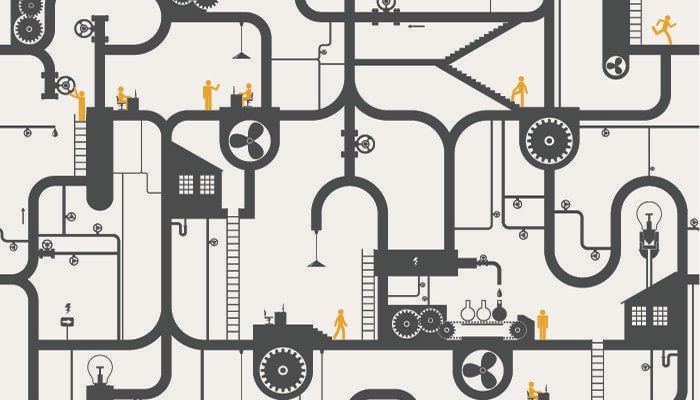Digital Twins Help To Avoid Unpredictable Plant Downtimes
Apr 11, 2019 • Features • Future of FIeld Service • manuel grenacher • SAP • Service Delivery • Industry 4.0 • Customer Satisfaction and Expectations
Digital Twins have been discussed in tech circles for a while now, but their potential value in field service is still only just beginning to filter through, Manuel Grenacher, SAP Field Service Management, explains the role they could play in improving service delivery.
Have you ever considered the possibilities and potential of digital twins for your customer service? Don’t worry, we are not talking about virtual figures in cyberspace that are modelled after the user just like avatars.
A digital twin represents a real object in the digital world. Digital twins are composed of data and algorithms and can be coupled with the real world via sensors. They form the basis for a digital customer service and other industry 4.0 related processes. In short, “digital twins” recreate a system in the computer. Ideally, data from the engineering phase – from 3D models to detailed information on installed components – is transferred to the operating phase.
Sensors provide live information on operating conditions, and in addition, all technical innovations on the system, such as the installation of a spare part, are tracked in the “digital twin”. Users benefit from more accurate real-time information and they get a detailed “reference book” with all service information they need.
But how can companies use the advantages of digital twins for their customer service? Digital twins enable the implementation of predictive maintenance since they allow data to be assigned to specific plant conditions. Thus, changing measuring conditions often show in advance that a certain component will fail in the foreseeable future. This allows planned system downtimes to be better coordinated and repair cycles to be adapted to expected failure probabilities.
Requirements For Digital Twins In Service
Sufficient sensors and a systematic evaluation of the data are the essential basis to predict imminent component failures – an approach that is already feasible today. However, technical possibilities are still far from being exhausted right now.
Due to ongoing depreciations or for other economic reasons, companies are only gradually investing in plants equipped with modern IoT technology. IoT, however, will become more affordable in the near future. Sensors will therefore spread continuously while at the same time becoming easier to use, more resistant and cheaper.
Enabling New Business Models, A Recipe For Digital Success
Industry 4.0 cannot work without a well-planned and technologically underpinned digital service concept, because service is an essential part of digitization. Many companies today already try to stand out with the quality of their service rather than just great products since they are often too similar, even exchangeable.
Customers therefore primarily choose the partner that offers more and faster service. The goal of every company should therefore be to better understand its customers, create better touchpoints and improve service.
This is where new concepts such as “machine-asa-service” become more and more important: companies only purchase the performance of a machine instead of the machine itself – including the service to ensure constant performance. Service Lifecycle Management plays a central role in this concept. In the future, entire ecosystems will emerge from new service providers using concepts like this.
Digital Twins Will Revolutionize Customer Service
Digital twins with their immense data material in both service and business intelligence offer the potential to create entirely new areas of business. Sensors allow to map and control machine statuses and product quality in real time – as well as predicting problems at an early stage. This way, service can intervene before expensive machine failures occur.
Furthermore, companies can dynamically adapt maintenance intervals to actual requirements on the basis of live information. In the future, all of a company’s systems as well as all of its spare parts, tools, containers and products, will be represented by their “digital mirror images”, a complete factory in the computer. The large amount of data that can be collected using digital twins in combination with artificial intelligence evaluation will provide stunning new insights into the interaction of operating processes.
This will lead to fully automated smart factories, which, thanks to artificial intelligence and digital twins, can control themselves practically without human intervention
Manuel Grenacher, is GM at SAP Field Service Management.
Have you ever considered the possibilities and potential of digital twins for your customer service? Don’t worry, we are not talking about virtual figures in cyberspace that are modelled after the user just like avatars.
A digital twin represents a real object in the digital world. Digital twins are composed of data and algorithms and can be coupled with the real world via sensors. They form the basis for a digital customer service and other industry 4.0 related processes. In short, “digital twins” recreate a system in the computer. Ideally, data from the engineering phase – from 3D models to detailed information on installed components – is transferred to the operating phase.
Sensors provide live information on operating conditions, and in addition, all technical innovations on the system, such as the installation of a spare part, are tracked in the “digital twin”. Users benefit from more accurate real-time information and they get a detailed “reference book” with all service information they need.
But how can companies use the advantages of digital twins for their customer service? Digital twins enable the implementation of predictive maintenance since they allow data to be assigned to specific plant conditions. Thus, changing measuring conditions often show in advance that a certain component will fail in the foreseeable future. This allows planned system downtimes to be better coordinated and repair cycles to be adapted to expected failure probabilities.
Requirements For Digital Twins In Service
Sufficient sensors and a systematic evaluation of the data are the essential basis to predict imminent component failures – an approach that is already feasible today. However, technical possibilities are still far from being exhausted right now.
Due to ongoing depreciations or for other economic reasons, companies are only gradually investing in plants equipped with modern IoT technology. IoT, however, will become more affordable in the near future. Sensors will therefore spread continuously while at the same time becoming easier to use, more resistant and cheaper.
"A digital twin represents a real object in the digital world..."
Enabling New Business Models, A Recipe For Digital Success
Industry 4.0 cannot work without a well-planned and technologically underpinned digital service concept, because service is an essential part of digitization. Many companies today already try to stand out with the quality of their service rather than just great products since they are often too similar, even exchangeable.
Customers therefore primarily choose the partner that offers more and faster service. The goal of every company should therefore be to better understand its customers, create better touchpoints and improve service.
This is where new concepts such as “machine-asa-service” become more and more important: companies only purchase the performance of a machine instead of the machine itself – including the service to ensure constant performance. Service Lifecycle Management plays a central role in this concept. In the future, entire ecosystems will emerge from new service providers using concepts like this.
Digital Twins Will Revolutionize Customer Service
Digital twins with their immense data material in both service and business intelligence offer the potential to create entirely new areas of business. Sensors allow to map and control machine statuses and product quality in real time – as well as predicting problems at an early stage. This way, service can intervene before expensive machine failures occur.
Furthermore, companies can dynamically adapt maintenance intervals to actual requirements on the basis of live information. In the future, all of a company’s systems as well as all of its spare parts, tools, containers and products, will be represented by their “digital mirror images”, a complete factory in the computer. The large amount of data that can be collected using digital twins in combination with artificial intelligence evaluation will provide stunning new insights into the interaction of operating processes.
This will lead to fully automated smart factories, which, thanks to artificial intelligence and digital twins, can control themselves practically without human intervention
Manuel Grenacher, is GM at SAP Field Service Management.





















 Field Service News is published by 1927 Media Ltd, an independent publisher whose sole focus is on the field service sector. As such our entire resources are focused on helping drive the field service sector forwards and aiming to best serve our industry through honest, incisive and innovative media coverage of the global field service sector.
Field Service News is published by 1927 Media Ltd, an independent publisher whose sole focus is on the field service sector. As such our entire resources are focused on helping drive the field service sector forwards and aiming to best serve our industry through honest, incisive and innovative media coverage of the global field service sector.
Leave a Reply